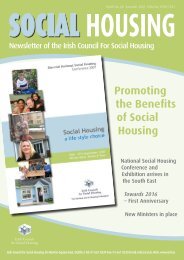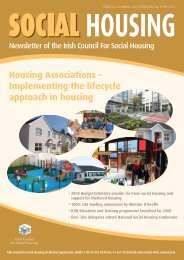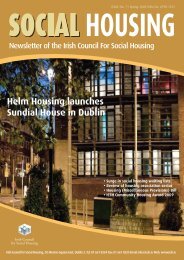National Housing Strategy for People with a Disability 2011 - 2016
National Housing Strategy for People with a Disability 2011 - 2016
National Housing Strategy for People with a Disability 2011 - 2016
You also want an ePaper? Increase the reach of your titles
YUMPU automatically turns print PDFs into web optimized ePapers that Google loves.
are fully wheelchair accessible, however they are also designed to meet the needs ofpeople who may have reduced mobility. In general the apartments give people theopportunity to live either independently or semi independently. This af<strong>for</strong>ds the tenantadditional security and peace of mind as, if they are in difficulty, they can alert supportstaff next door through the Nursecall system. Due to the success of this model it has beenreplicated nationally.In one of Newgrove <strong>Housing</strong> Association’s independent apartments a tenant <strong>with</strong> a hearingimpairment has been given the opportunity to live independently through the use oftechnology. In this case, an individual <strong>with</strong> a hearing impairment uses DeafHeartechnology to undertake simple activities such as answering the door, using an alarm clock,watching television or making a phone call, which requires quite complex adaptivetechnology - the lack of which can leave people isolated and erode independence.Without adapted smoke alarms and other such alerting devices such as thehandheld device programmed to the fire alarm system in the apartment, safety maybe compromised.This technology, along <strong>with</strong> the additional safety features such as strobe lights thatare connected to the fire alarm system, help prevent risk. In this case, technologyhas allowed an individual to live independently <strong>for</strong> the first time in his life.Home Solutions Study8.41 The Home Solutions Research Study, which was funded by the DECLG andundertaken by the HSE in conjunction <strong>with</strong> the Department of Health, the Department ofSocial Protection and local authorities, was launched on 25 March, <strong>2011</strong>. The aim of theproject was to investigate the benefits of telecare <strong>for</strong> older people choosing to remain athome. One of the main conclusions of the study was that “Telecare systems are effective insupporting older people <strong>with</strong> significant needs to remain at home, even when otherwiseassessed as being in need of residential or similar <strong>for</strong>ms of care”.8.42 The main recommendations of the study include, inter alia:• Telecare should be regarded as a substantive ingredient of home care servicesespecially <strong>for</strong> people <strong>with</strong> high levels of need and those who are assessed as likely toneed residential or similar <strong>for</strong>ms of care;• The HSE and DECLG should further develop assessment arrangements and facilitiesto support the deployment of telecare care services that will support dependentpersons;97









